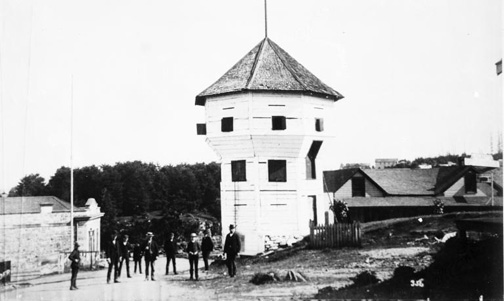The Hudson's Bay Company on Vancouver Island
The Hudson’s Bay Company began construction of the Bastion in 1853. Today, the Bastion is the most recognizable landmark in Nanaimo.
Visit the Bastion in Summer 2025 or book a group tour!
Open hours:
June 28 – September 1 on Saturdays, Sundays, and Stat Holidays between 11:00 am and 3:30 pm.
Please check Google for the most up-to-date Bastion hours. Group tours are available for booking. Cannon firings are cancelled until further notice.
Bastion Lighting Requests:
The City of Nanaimo handles Bastion Light-up requests. Please visit their website for the application form: https://www.nanaimo.ca/your-government/city-council/bastion-lighting-requests, or see the colours in action with this Youtube Video: https://youtu.be/OdwX7Pf0plM
Interior

First Floor

Second Floor

Third Floor
Construction, Moving and Renovation

Left: The Bastion being moved in 1974. Right: The Bastion undergoing restoration work in 2010.
Originally, the Bastion was situated on the present-day location of the Dorchester Hotel parking lot. However, by 1891, the land was sold and the new owner threatened to demolish the structure. A contribution of $175 from the city saved the Bastion and it was moved across Front Street. The Bastion was moved again in 1974 when Front Street was widened.
Restoration in 2010 repaired and replaced some of the ageing parts of the Bastion, although the majority of the timbers and other components of the structure are original.

